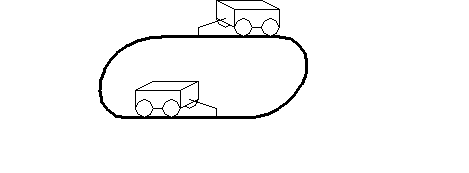
• Basic purpose is to provide automatic transfer of workparts between automated machines, and interface with individual work stations.
• Basic layouts for material handling include,
- lines - stations arranged along a fixed part transfer path.
- batch - stations are grouped by function and batches of raw materials/WIP are brought in batches
- job shop - individual parts are carried through one or more stages by one worker
- job site - equipment is brought to the work
• These transfer systems can also be categorized by their timing approach,
- synchronous - the entire line moves parts with a fixed period cycle. This is well suited to mass production of similar products.
- asynchronous - parts are moved as completed or needed. Often buffers are required, but this is more tolerant of problems than synchronous systems.
- continuous - the product flows by without stopping
• Random, independent movement of palletized workparts between workstations in the FMS
- pallets can flow from any station to any other
- parts are mounted in pallet fixtures
- pallets can move independently to avoid interference
• Temporary storage or banking of workparts
- queues allow parts to wait for machines, thus increasing efficiency
• Convenient access for loading and unloading workparts
- easy to do manual load/unload.
- automatic loading/unloading of parts at workstations
- can load/unload from either side of system
• Compatible with computer control
• Provision for future expansion
- modular extensions to system are desirable
• Adherence to all applicable industrial codes
- allow unobstructed floor level access to each workstation
• Operation in shop environment
- must be reliable when exposed to metal chips, cutting fluids, oil, dirt, etc.
• Common type of Material handling systems

- power and free overhead conveyors



• When small parts are hard to orient we can dump them in a vibratory feeder.
• The vibrations cause parts to ‘hop’ forward.
• Various cutouts, tracks, etc are added to sort parts.
(ans. to acts as holders for work that is being transported)
2. List possible methods for guiding an AGV.
(ans. guide wire, vision, painted lines, chain)
• For this lab the class will be divided into two halves. One group will do part A, the other group will do part B. Both groupswill have to work together for a successful lab.
• System Objective: When done the system should be able to pass a shuttle in a continuous loop.
The SoftPLC and devicenet will be used to control the material handling system Lock and go stations.
The material handling system is designed in a modular format. Each of the track sections can be disassembled and reassembled in other configurations. In total there are,
6 straight track sections (2 have stands for suspending overhead gear)
1 conveyor system for a straight track section
The material handling system will be outfitted with the devicenet based controls system to move the shuttles around the system. This system will be added to in later labs. The shuttles are actuated using solenoid valves for an air supply. By actuating the “lock and go” stations the cart can be stopped, or ejected.
Examine the system components and determine (as a group) how the system will work. Implement ladder logic to control the system.
1. Connect the track sections.
2. Connect solenoid valves to the “lock an go” stations - except on the turnstations. Add sensors to detect the presence of a shuttle
3. Wire the solenoid valves to the softPLC and write the ladder logic required to control the stations.